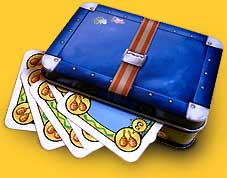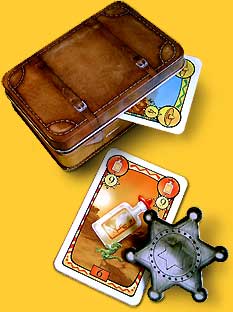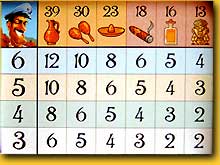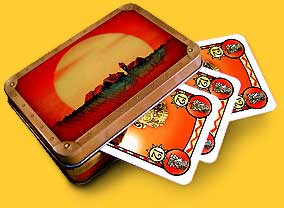Hart an der Grenze
Authors: André Zatz & Sergio Halaban
Publisher: Kosmos
Year: 2006
review by

| x |
|
|
|
|
|
|
|
|
|
|
|
|
|
|
|
|
|
|
|
|
|
|
|
|
|
|
|
|
|
|
|
|
|
|
|
|
|
|
 |
It is the last day of the holiday and we use it for some final shopping at the local market. There it teems with enticing offers. Apart from the usual souvenirs like samba balls for aunt Edlyn and a sombrero for uncle Jarvis we also see some varying items like hand made sigars, liquor, and antique little sculptures. We never saw them come that cheap, usually they cost a little fortune! The only concern is to get these not quite legal items through customs. Oh well, never mind, they are always quite busy, we’re sure we’ll manage to slip through! Oops, was that call for us? Open the suitcase? Ehm, we try a subtle attempt to bribe: ‘Well my dear man, perhaps I could assist you in the costs for your little daughter’s study? And there would be no need to open my suitcase and go through my dirty knickers? As you do know of course that your country’s olive oil is very violent to our civilised stomachs?’ |
| x |
|
|
|
|
|
|
|
|
|
|
|
|
|
|
|
|
|
|
|
|
|
|
|
|
|
|
|
|
|
|
|
|
|
|
|
|
|
|
| This is approximately how it will go in this game, where each turn another player takes the role as a customs official and tries to interpret the poker faces. Real tiny tin suitcases are available to the players, in which they hide one to five good cards. Following this, they declare what goods they are carrying, where at least the amount of good cards must be right: ‘Oh, nothing special, just three sombreros!’ ‘And I carry five vases; they were such a bargain!’ ‘A set of samba balls.’ ‘Two sombreros.’ What to do with this? It is very likely that among the legal goods an antique sculpture is hidden, and even maybe two or more! |
 |
| x |
|
|
|
|
|
|
|
|
|
|
|
|
|
|
|
|
|
|
|
|
|
|
|
|
|
|
|
|
|
|
|
|
|
|
|
|
|
|
|
|
A player only may declare one type of goods, legal or not. Two sombreros and a vase, however evenly legal, are at the border declared as Three sombreros or three vases. Illegal items as sigars, liquor or sculptures are ofcourse not mentioned at all but declared as ‘innocent’ legal goods like sombreros, sigars, or vases. |
| x |
|
|
|
|
|
|
|
|
|
|
|
|
|
|
|
|
|
|
|
|
|
|
|
|
|
|
|
|
|
|
|
|
|
|
|
|
|
|
When the suitcase has been opened and it turns out to contain illegal or not declared goods, a fine has to be paid, to the bank, the goods are confiscated and are removed from the game. But the customs officer is susceptible to bribery, and money is what this game is about. When a player is subject to a check, the others are lucky and may walk freely (which makes a nice story for home: ‘It was thís close!’), and may store the goods on a separate stack in front of their suitcase. Each player has a stone with which he once in a game, when in the role of the customs officer, may perform another check on an additional player.
| x |
|
|
| x |
x |
 |
If the goods are all legal, and they match with the goods declared, the player gets a small payment from the bank, the height of which is shown on each goods card. When they are illegal, the amount shown must be paid to the bank. |
 |
| x |
 |
Besides his one or two checks a customs officer once a game has the possibility to peek in the suitcase of a player and take out all legal or illegal goods that did not match the declaration of goods the concerning player made. The customs officer may confiscate and store these goods on his own saved stack.
After each turn, every player fills his hand to five and a turn begins with a new customs officer.
|
| x |
|
|
|
|
|
|
|
|
|
|
|
|
|
|
|
|
|
|
|
|
|
|
|
|
|
|
|
|
|
|
|
|
|
|
|
|
|
|
| Once every player has played the role of customs officer, a round ends. The goods that have been smuggled into the country now all are sold against the price that is on the card. Per round three cards may be saved to be sold at games end; these goods may or may not bring possible double income at that time. |
|
 |
|
After three rounds these saved goods are offered by all players, all at once, but there is a varying limit for every item that can be sold. The player with the most saved goods for a specific item may sell his goods first, up to the limit for that item. After that, other players in turn sell their goods, again up to the limit, until the limit has been reached. Other players goods cards are rendered worthless. At the end, the player with the most money wins the game. |
| x |
|
|
|
|
|
|
|
|
|
|
|
|
|
|
|
|
|
|
|
|
|
|
|
|
|
|
|
|
|
|
|
|
|
|
|
|
|
|
 |
|
|
|
|
|
|
|
|
|
|
|
|
|
|
|
|
|
|
|
|
|
|
|
|
|
|
|
|
|
|
|
|
|
|
| De little tin suitcases are the gimmick of the game; they all have beautiful designs, and there even is a suitcase with a ‘Settlers of Catan’ print on it! Every turn a player has to make the decision which goods he will put in the suitccase to try to smuggle it out of the country. When a player has not been checked for a long time, the chances are more likely he will be checked this or next turn by a new customs officer so it would be wise to store the suitcase with legal goods of one item only and confess the contents upon request. On the other hand: to minimise the risk, should the sculptures not better be put in the suitcase all at once? In particular when a player was checked last turn and he had only legal items in his suitcase, thereby showing his honesty, at least at that time? But isn’t it a bit too conspicious then, to declare five (five!) 'sombreros'? |
 |
|
|
|
The separate stacks in front of the suitcase, under the suitcase, and the hand cards, are easily to be mixed during the game, moreover because every turn the suitcases have to be opened to get the cards out, for a customs check, or to store them. Because the cards are somewhat difficult to get out of the suitcase, players tend to take it in their hands and shake the cards out, meanwhile leaving three nondescript stacks of cards on the table. And which stack was my hand cards then again? |
| x |
|
|
|
|
|
|
|
|
|
|
|
|
|
|
|
|
|
|
|
|
|
|
|
|
|
|
|
|
|
|
|
|
|
|
|
|
|
|
The size of the money has been exaggerated; it is clear what the game is about. The sheriff star that every player has to attach when it is his turn to check the luggage as a customs officer also contributes to the atmosphere of the game.
‘Hart an der Grenze’ has a high hilarious atmosphere; it is funny to see the poker faces of the players whilst declaring only innocent wares. This typically is a game in which players will have to act a little to flavour the atmosphere. But it is doubtful if playing the game after a couple of times will offer the same amount of enjoyment; the zany atmosphere is boring fast. Besides, not everyone is equally good in acting, and not everyone shares the same sense of -dated- humour. |
|
| x |
|
|
|
|
|
|
|
|
|
|
|
|
|
|
|
|
|
|
|
|
|
|
|
|
|
|
|
|
|
|
|
|
|
|
|
|
|
|
 |
We had a reminiscence of Heinz Rühmann, Mickey Rooney, ‘Die Drei von der Tankstelle’ and ‘Car 54, Where Are You?’. Probably it is this kind of humour that the game wants to trigger. This said, the game would be more appropriately set in a different, more innocent world. Regretfully, these innocent times are gone...
© 2006 Richard van Vugt
Hart an der Grenze, André Zatz & Sergio Halaban, Kosmos, 2006 - 3 to 6 players, 10 years and up, 45 to 70 minutes
|
  |
|
|
|
|
|
|
|
|
|
|
|
|
|
|
|
|
|
|
|
|
|
|
|
|
|
|
|
|
|
|
|
|
|
|
  |
|
|
|
|
|
|
|
|
|
|
|
|
|
|
|
|
|
|
|
|
|
|
|
|
|
|
|
|
|
|
|
|
|
|
  |
|
|
|
|
|
|
|
|
|
|
|
|
|
|
|
|
|
|
|
|
|
|
|
|
|
|
|
|
|
|
|
|
|
|
  |
|
|
|
|
|
|
|
|
|
|
|
|
|
|
|
|
|
|
|
|
|
|
|
|
|
|
|
|
|
|
|
|
|
|
| x |
|
|
|
|
|
|
|
|
|
|
|
|
|
|
|
|
|
|
|
|
|
|
|
|
|
|
|
|
|
|
|
|
|
|
|
|
|
|
| x |
|
|
|
|
|
|
|
|
|
|
|
|
|
|
|
|
|
|
|
|
|
|
|
|
|
|
|
|
|
|
|
|
|
|
|
|
|
|
 |
|
|
|
|
|
|
|
|
|
|
|
|
|
|
|
|
|
|
|
|
|
|
|
|
|
|
|
|
|
|
|
 |
|
|
|
|
|
|
|
|
|
|
|
|
|
|
|
|
|
|
|
|
|
|
|
|
|
|
|
|
|
|
|
| x |
|
|
|
|
|
|
|
|
|
|
|
|
|
|
|
|
|
|
|
|
|
|
|
|
|
|
|
|
|
|
|
|
|
|
|
|
|
|
 |
|
|
|
|
|
|
|
|
|
|
|
|
|
|
|
|
|
|
|
|
|
|
|
|
|
 |
|
|
|
|
|
|
|
|
|
|
|
|
|
|
|
|
|
|
|
|
|
|
|
|
|
|
|